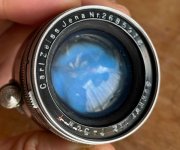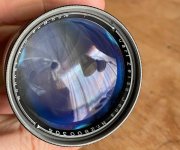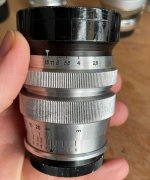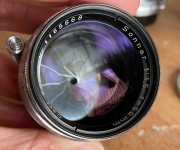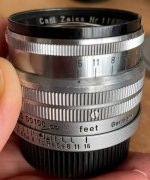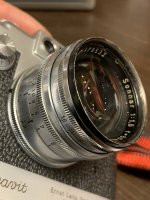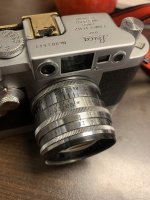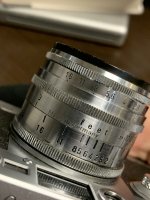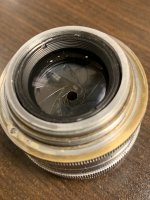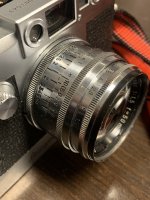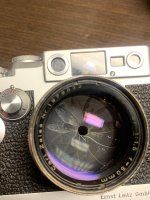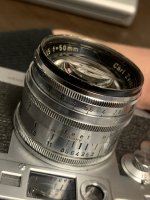TenEleven
Well-known
I have been wanting to make this particular posting for a while but put it off time and time again.
Well, now's the time. In this post I want to share some of the strange lenses that I have accumulated over the years of looking for Zeiss stuff. Most of these will be Leica (L39) mount but there is a Contax mount one as well.
Furthermore, for the sake of brevity and to not repeat a lot of info that Brian already has posted - I'm going to be mostly skipping over the "standard" LTM war-time lenses which range from 28mm to 135mm and their Contax-mount brothers. All lenses focus correctly to their appropriate standards unless otherwise mentioned.
Wartime LTM Sonnar 5cm f/1.5 - Full Brass Finish
Let's start with a lens that's not particularly strange, just rare. It's your typical, albeit early war-time LTM Sonnar lens. It's been finished in brass entirely - even the helical, lens mounts and everything is made of brass - making it a very heavy and dense lens. It is in fact at 236 grams (8.3oz) heavier than even the Lomography Jupiter3+ which comes in at 219 grams (7.7oz). Sadly it has seen a lot of use so the helical needed some heavy grease to prevent any wobble.



Post-war LTM Sonnar 5cm f/1.5 - Aluminum Mount
These are, to my understanding at least, legit. The Thiele is mum on them but they appear in the correct serial lots. I have seen several of these and they all have the same, rather simplistic construction of a helical ground into the back of the lens over which then the rear part is simply "screwed on" - the only thing stopping you from fully unscrewing it is a screw thread into the rear part that rides along a groove that has also been cut into the rear mount. Interesting hour-glass shape. Finished in 1947. Weighing in at 136grams (4.7oz)



??? LTM Sonnar 5cm f/2 - Aluminum (Re?)Mount
Continuing the hour-glass theme, we have this very light-weight all aluminum 5cm f/2 Sonnar LTM lens. It has a strange serial number that is however appropriate to a 5cm f/2 Sonnar, according to the Thiele book it was made in 1937 and comes out of a lot of 3000. It's quite possible that this was either re-mounted or had been lying around in the Zeiss factory and finished post war as the design of the front bezel is more reminiscent of very late post war Sonnars. Surprisingly it focuses (accurately!) down to 0.7m exactly with RF coupling. Very curiously it takes 41mm as opposed to the usual 40.5mm filters. Leitz SOOEY adapter fits. Weighs a mere 100 grams (3.5oz)


Wartime LTM Sonnar 5cm f/2 - Brass & Nickel Mount - Collapsible
Next up we have a quite early collapsible LTM 5cm f/2 Sonnar. Interestingly it is finished in Brass with a Nickel coat. It weighs a rather hefty 212g (7.4oz) compared to its more normal Aluminium finished brother weighing in at almost exactly half that 110g (3.8oz). Also furthermore as shown mounted here it has the "period typical" 11'o-clock focus-tab position for the lens locked at infinity. Fittingly it was ordered in 1932, in a lot of 5000 but as the Thiele dryly states: "Beleg Fehlt" - missing finishing slip. Very curious.




Continued below...
Well, now's the time. In this post I want to share some of the strange lenses that I have accumulated over the years of looking for Zeiss stuff. Most of these will be Leica (L39) mount but there is a Contax mount one as well.
Furthermore, for the sake of brevity and to not repeat a lot of info that Brian already has posted - I'm going to be mostly skipping over the "standard" LTM war-time lenses which range from 28mm to 135mm and their Contax-mount brothers. All lenses focus correctly to their appropriate standards unless otherwise mentioned.
Wartime LTM Sonnar 5cm f/1.5 - Full Brass Finish
Let's start with a lens that's not particularly strange, just rare. It's your typical, albeit early war-time LTM Sonnar lens. It's been finished in brass entirely - even the helical, lens mounts and everything is made of brass - making it a very heavy and dense lens. It is in fact at 236 grams (8.3oz) heavier than even the Lomography Jupiter3+ which comes in at 219 grams (7.7oz). Sadly it has seen a lot of use so the helical needed some heavy grease to prevent any wobble.



Post-war LTM Sonnar 5cm f/1.5 - Aluminum Mount
These are, to my understanding at least, legit. The Thiele is mum on them but they appear in the correct serial lots. I have seen several of these and they all have the same, rather simplistic construction of a helical ground into the back of the lens over which then the rear part is simply "screwed on" - the only thing stopping you from fully unscrewing it is a screw thread into the rear part that rides along a groove that has also been cut into the rear mount. Interesting hour-glass shape. Finished in 1947. Weighing in at 136grams (4.7oz)



??? LTM Sonnar 5cm f/2 - Aluminum (Re?)Mount
Continuing the hour-glass theme, we have this very light-weight all aluminum 5cm f/2 Sonnar LTM lens. It has a strange serial number that is however appropriate to a 5cm f/2 Sonnar, according to the Thiele book it was made in 1937 and comes out of a lot of 3000. It's quite possible that this was either re-mounted or had been lying around in the Zeiss factory and finished post war as the design of the front bezel is more reminiscent of very late post war Sonnars. Surprisingly it focuses (accurately!) down to 0.7m exactly with RF coupling. Very curiously it takes 41mm as opposed to the usual 40.5mm filters. Leitz SOOEY adapter fits. Weighs a mere 100 grams (3.5oz)


Wartime LTM Sonnar 5cm f/2 - Brass & Nickel Mount - Collapsible
Next up we have a quite early collapsible LTM 5cm f/2 Sonnar. Interestingly it is finished in Brass with a Nickel coat. It weighs a rather hefty 212g (7.4oz) compared to its more normal Aluminium finished brother weighing in at almost exactly half that 110g (3.8oz). Also furthermore as shown mounted here it has the "period typical" 11'o-clock focus-tab position for the lens locked at infinity. Fittingly it was ordered in 1932, in a lot of 5000 but as the Thiele dryly states: "Beleg Fehlt" - missing finishing slip. Very curious.




Continued below...


